What are Layer-1 and Layer-2 in Blockchain? Differences and similarities

The blockchain industry has surely advanced since its beginning in 2009. More and more protocol networks emerge every year, usage continuously increases and old gems like Bitcoin and Ethereum keep on shining. And despite consumer usage being the main goal it is also a blockchain’s worst nightmare.
In reality, there are three aspects of the blockchain technology that must be balanced - decentralization, security and scalability. In practice, that becomes impossible, as emphasis is most often on consensus and decentralization, and is known as the “blockchain trilemma” as there is always one aspect that is neglected for the benefit of the other two. In many cases it is the scalability factor, leading to one blockchain common issue - the so-called “scaling problem”.
Explaining the scaling issue
The scaling problem affects Layer 1 blockchains. Put in simple terms, it refers to the difficulties protocol networks face in regards to processing speed and capacity increase in order to be able to successfully handle more transactions, users, and dApps (decentralised applications) at greater speed, all without compromising security or decentralization. This is due to a design flaw in the blockchain technology itself that doesn’t allow for easy scaling. Ergo, the greater usage of a protocol can lead to slower processing times and higher fees. This is especially true for large and established blockchains like Bitcoin and Ethereum.
Technically, scaling L1 protocols is possible but only through updates to the core technology, which can be intense, risky and take a long time to code and push into effect. It also affects the blockchain users and their ongoing processes on the protocol network. Examples include:
- Sharding - similar to database partitioning; it is a mechanism which breaks a blockchain into smaller, more easily manageable pieces called shards, each of which can process transactions and smart contracts independently.
- Updating the block size - a method through which the code is rewritten to reflect a larger block, hence increasing the network’s capacity.
- Updating the consensus mechanism - a technique of improving the algorithm used by a blockchain to validate transactions, which enhances the overall blockchain performance.
- Improving block propagation - a method to improve the rate and efficiently at which blocks are shared across the network, in order to improve the blockchain’s efficiency.
- Layered Architectures - a workaround-the-issue-of-changing-the-code technique to create and use layered solutions to increase a blockchain’s throughput and performance without risking security or decentralization, e.g. Layer 2 blockchain solutions.
Layer v2 blockchains, or Layer 2 blockchain solutions, strive to improve the blockchain throughput, overall performance and scalability.
No matter your role in the cryptocurrency industry, whether you are a developer, blockchain enthusiast, shareholder, venture capitalist, crypto researcher, or simply an influencer, understanding the Layer 1 and Layer 2 blockchain terms is key to decoding the blockchain technology’s intricate infrastructure.
Explaining Layer 1
Layer 1 represents the foundational blockchain layer. It has its own native cryptocurrency and runs processes independently on its own infrastructure. Layer 1 blockchains are the platforms that actually process and verify transactions, establish consensus, maintain the Ledger and the general security of the network. Examples of Layer 1 (or L1) blockchains include Bitcoin, Ethereum, Solana, Avalanche, BSC and more.
Main Consensus mechanisms in Layer 1 blockchains are:
- Proof-of-Work (PoW) - a mechanism in which miners (i.e. nodes) compete to solve challenging and advanced mathematical tasks in order to validate transactions and add new blocks to the blockchain.
- Proof-of-Stake (PoS) - a mechanism where instead of miners it is validators that are chosen to create new blocks based on the number of cryptocurrency tokens they have and are willing to "stake."
It is the Layer 1 framework that faces blockchain scaling issues. L1 blockchains have low transaction throughput, i.e. they cannot handle a lot of transactions per second (TPS).
For example:
- Bitcoin can process 7 TPS;
- Ethereum can process 15-30 TPS.
These limits are fixed and the higher the usage of the protocol network, the more bottlenecked it becomes, leading to longer processing (confirmation) times and higher fees. In comparison, traditional payment networks like MasterCard and Visa process more than hundreds of TPS. Hence, the desire to increase the processing power and capabilities of L1 blockchains, which happens through overlaid frameworks called Layer 2.
Explaining Layer 2
Layer 2 is the term for the mechanism created to operate off-chain on top of the main L1 chain. These can be protocols and various solutions that are designed to literally take the load off the primary blockchain, process the transactions and return the results in batches to the main chain.
This is how throughput is increased, performance is improved and the L1 blockchain becomes virtually scalable.This aspect is of paramount importance to applications that have the need to scale, e.g. high-volume dApps or any DeFi platforms. At the same time while transaction speed increases, fee amounts decrease, which makes L2 solutions much preferred among blockchain users and enthusiasts.
Moreover, L2 solutions do not modify the core protocol, but rather simply operate independently while interacting with it. They also use the base protocol’s security rather than a separate method.
Some of the types of Layer 2 solutions are:
- Rollups - a mechanism that bundles numerous transactions into a single batch that is submitted to the main chain. There are two types of rollups - Optimistic rollups and ZK-rollups.
- State channels - a technique through which transactions are conducted off-chain and only the final state is recorded on the main chain.
- Sidechains - separate blockchain protocols that run in parallel to the main chain vehicle connected through a two-way peg.
The differences at quick glance
Here is a more simplified look of the differences between L1 and L2 blockchains:
| Attribute | Layer 1 | Layer 2 |
|---|---|---|
| Definition | The core, base, foundational blockchain protocol. | An additional mechanism built on top of the main protocol that processes data and returns it to the main layer in batches. |
| Transaction speed (Throughput) | Fixed, depending on the protocol itself; low. | Increased as processing happens off-chain. |
| Fees | Higher due to network congestion. | Lower due to higher processing speed and overall increased throughput. |
| Scalability | Limited, possible only through direct changes to code. | Highly scalable without changes to the core code. |
| Security | Highly secured with own mechanisms. | Relies on the main chain for security. |
| Examples | Bitcoin, Ethereum, Solana, Avalanche, BSC | Optimism, Arbitrum, Base |
How do L1 and L2 solutions fit with Vaultody?
The short answer is - completely!
Vaultody can support operations and transactions on both Layer 1 and Layer 2 blockchains. We continuously add assets and protocols to Vaultody and currently we support Level 1 blockchains such as Bitcoin, Ethereum and Avalanche, and Level 2 solutions like Polygon, Base, Optimism and Arbitrum.
Our product does everything for you from preparing the transaction, through signing it and finally - seamlessly broadcasting it, after which it informs you via webhook notifications for each completed step. It really makes no difference on which protocol solution these would process. Layer 1 or Layer 2 - all operations are effortless and successful. In this respect, any customer of Vaultody, whether they are tech-savvy or non-technical, can access and utilize all L1 and L2 benefits in a simple and convenient manner.
An example of Vaultody’s practical tools and products is the Gas Station. To understand why the Gas Station is so useful, we first need to explain what “gas” is.
A principle of work for most EVM-based blockchains is the requirement for a fee, i.e. “gas”. In order for transactions to be executed, gas must be paid in the specific blockchain’s native asset from the same address that initiated the transaction. Since all transfers occurring on the Vaultody platform, both internal and external, happen on the blockchain, you must pay gas fees when transferring funds from the deposit addresses to your omnibus vault account.
Vaultody’s Gas Station auto-fuels an address with the required and enabled native asset. It applies an auto-fuel transaction triggered whenever a withdrawal is detected from that vault. A great use case for this product are customers who choose to use the omnibus structure.
The benefits of using the Gas Station extend to speed, efficiency and cost. The Gast station saves its user the need of creating additional transactions and centralizes all transaction fees to effectively eliminate any wallet dust.
Another great example of a useful Vaultody feature, easily compatible with e.g. L2 solutions, is the Same Address feature.
Through this Vaultody users can employ a unified address for all supported EVM-based blockchains. This way human-related errors are easily reversible. For instance, executing transactions and sending funds to a wrong address is now a modifiable action.
The Same Address feature is, for all intents and purposes, an alignment between Ethereum and other EVM chains generated addresses. Two criteria need to be met, though - the numbering across addresses must match and all of the addresses must be from the same vault. If these are fulfilled, then Vaultody’s Same Address for all EVM-based chains is ready for use!
Conclusion
The “scaling problem” is a real issue in the blockchain industry and changing the core code of a protocol is not a light decision to make or an easy and quick task to do. But in a growing and fast-changing online world such as ours, scaling blockchain protocols is a complete must. This is why Layer 2 blockchain solutions are the perfect and safest route to take.




 Login
Login







 Copy link
Copy link